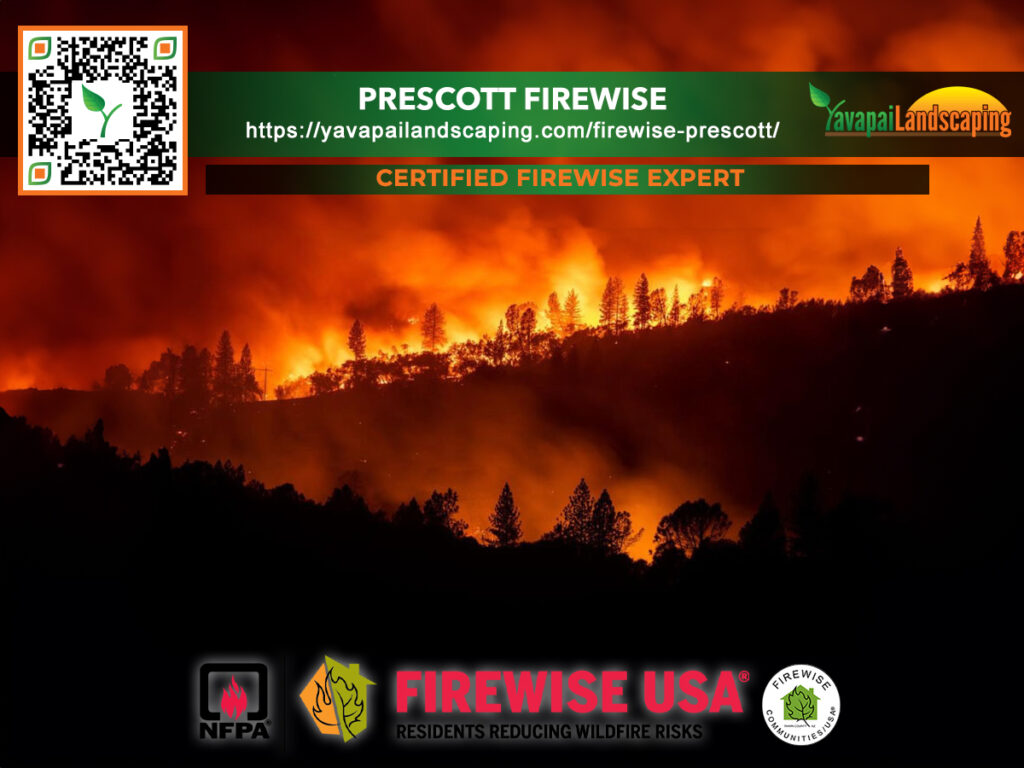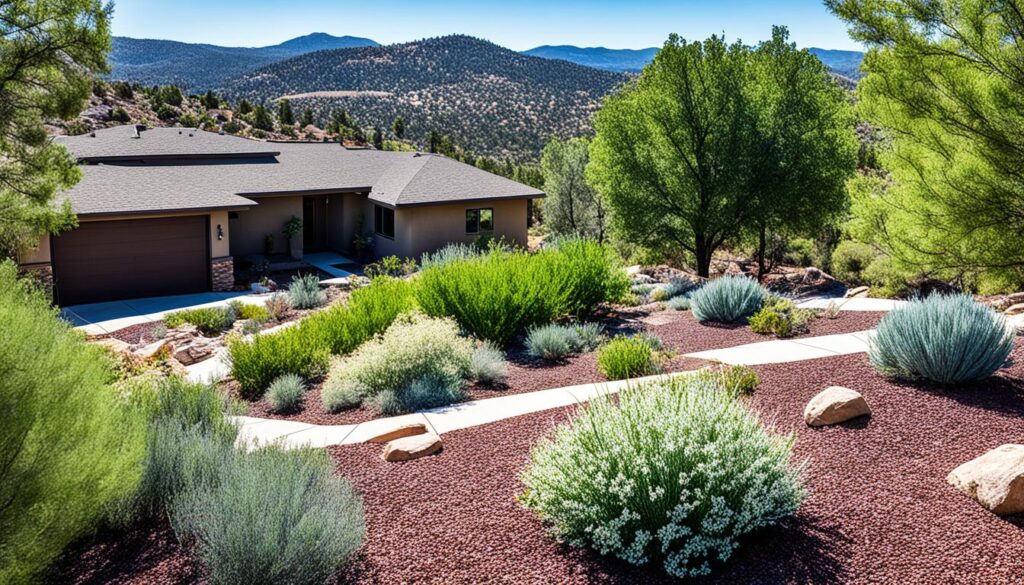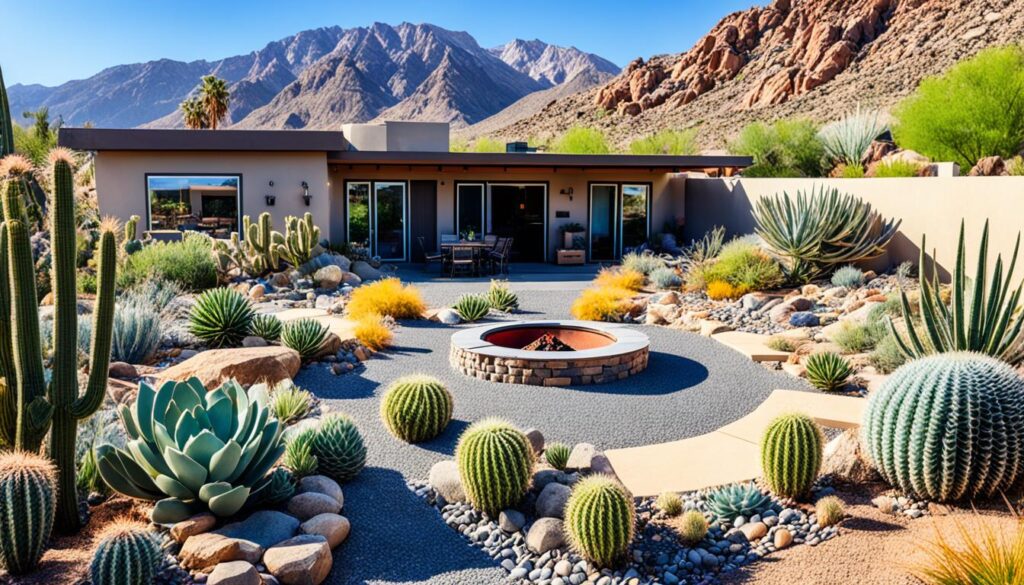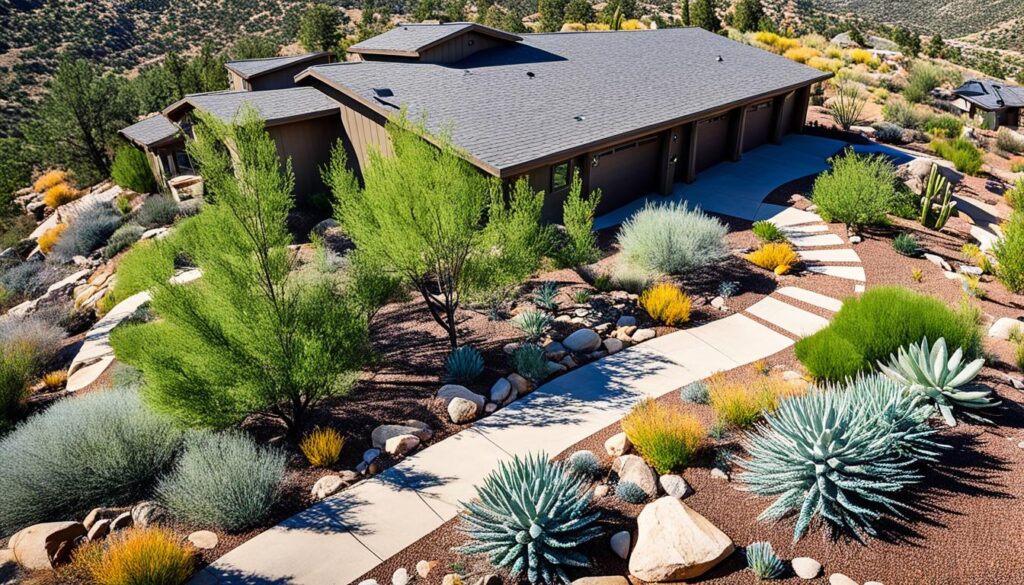
Living in an area prone to wildfires, such as Prescott, AZ, requires proactive measures to safeguard your home and property. Creating a firewise landscape, tailored to the unique conditions of Prescott, is a crucial step in wildfire prevention and ensuring the safety of your loved ones and belongings. By implementing Prescott firewise strategies, you can significantly reduce the risk of wildfire damage and promote a safer environment for your community.
But what exactly does it mean to have a firewise landscape? It involves implementing various strategies and practices that reduce the risk of fire ignition and minimize its potential spread. From incorporating fire-resistant landscaping techniques to using fire-safe building materials, there are several steps you can take to create a fire-resistant environment around your home.
Key Takeaways:
- Creating a firewise landscape is crucial in protecting your home from wildfires.
- Fire-resistant landscaping strategies can significantly reduce the chances of fire ignition and spread.
- Using fire-safe building materials fortifies your home against the risks of wildfires.
- Community involvement in wildfire preparedness plays a critical role in creating a resilient and firewise community.
- Ongoing maintenance and adherence to fire safety guidelines are necessary for sustaining a firewise landscape.
Understanding the Importance of Firewise Landscaping
When it comes to protecting your home from the devastating effects of wildfires, firewise landscaping plays a crucial role. By implementing certain landscaping techniques and practices, you can significantly reduce the risk of fire ignition and spread, enhancing the safety of your property.

One of the key aspects of firewise landscaping is creating a defensible space around your home. This involves removing flammable vegetation, such as dry shrubs and dead trees, from within a certain radius of your house. By doing so, you create a buffer zone that reduces the chance of flames reaching your property during a wildfire.
Beyond creating a defensible space, firewise landscaping also focuses on using fire-resistant plants and materials. This includes choosing vegetation that is less likely to ignite and spread fire, such as low-growing, high-moisture plants. Additionally, incorporating fire-safe building materials, such as non-combustible roofing and siding, can further fortify your home against the dangers of wildfires.
By embracing firewise landscaping strategies, you not only safeguard your property but also contribute to the overall resilience of your community. When homes within a neighborhood are designed and maintained to be fire-resistant, the chances of a wildfire spreading and causing extensive damage are significantly reduced.
Remember, prevention is key when it comes to wildfires. By understanding the importance of firewise landscaping and implementing the relevant strategies, you can significantly lower the risk posed by wildfires and protect your home and loved ones.

Fire-Resistant Landscaping Strategies for Wildfire Prevention
To create a firewise environment around your home and minimize the risk of wildfires, implementing specific fire-resistant landscaping strategies is crucial. By carefully selecting vegetation, ensuring proper plant spacing, and implementing other landscaping techniques, you can significantly reduce the fuel available for wildfires to ignite and spread.
Vegetation Choices
Choosing the right vegetation is essential for creating a fire-resistant landscape. Opt for plants that are less likely to ignite and produce minimal flammable or combustible material. Consider using native plant species as they are typically better adapted to local conditions and have evolved to coexist with frequent wildfires.
Proper Plant Spacing
Proper plant spacing plays a vital role in reducing fire risk. Ensure that there is adequate space between plants, shrubs, and trees to prevent fire from easily spreading. The fire-resistant zone should extend at least 30 feet around your home, with larger clearance if you live in an area at high risk for wildfires.
Landscaping Techniques
Incorporate landscaping techniques that help hinder the spread of wildfires. These techniques include:
- Creating fuel breaks by using non-flammable materials such as gravel or stone to separate vegetation areas.
- Using mulch made from fire-resistant materials like gravel or hardwood chips, instead of flammable materials like bark or pine needles.
- Maintaining a well-maintained lawn, regularly removing dead vegetation, and trimming tree branches that are close to your home.
- Installing irrigation systems to ensure the proper hydration of plants and vegetation, reducing their flammability.

Implementing these fire-resistant landscaping strategies will not only help protect your home but also contribute to the overall wildfire prevention efforts in your community. Remember to regularly maintain your firewise landscape to ensure its long-term effectiveness in mitigating fire risks. Educate yourself on What Are Firewise Services and How Can They Protect My Property in Prescott AZ.
Incorporating Fire-Safe Building Materials in Your Home
When it comes to protecting your home from the risks of wildfires, using fire-safe building materials is a crucial step. These materials are specifically designed to withstand high temperatures and slow down the spread of fire, providing essential protection to your property and loved ones. In this section, we will discuss various fire-resistant materials that you can incorporate into different parts of your home, such as roofing, siding, and windows, to enhance overall fire safety.
Fire-Resistant Roofing
One of the most vulnerable areas of your home during a wildfire is the roof. Choosing a fire-resistant roofing material can significantly reduce the risk of ignition and prevent fire from spreading to the interior. Some common fire-safe roofing options include:
- Class A asphalt shingles
- Metal roofing
- Concrete or clay tiles
- Slate or stone roofing
These materials have been tested and certified to meet strict fire safety standards, providing an extra layer of defense against wildfires.
Fire-Resistant Siding
Another important consideration is the siding of your home. Fire-resistant siding can help protect the structure and reduce the chances of fire spreading from neighboring buildings or vegetation. Some popular fire-safe siding materials include:
- Fiber cement siding
- Metal siding
- Stucco with embedded mesh
- Fire-resistant wood siding treated with fire-retardant chemicals
These materials are designed to resist ignition and slow down the progress of fire, offering increased protection to your home.
Fire-Resistant Windows
Windows are vulnerable entry points for radiant heat and flames during a wildfire. Installing fire-resistant windows can help prevent the breakage of glass, which can allow embers and flames to enter your home. Consider the following options for fire-safe windows:
- Tempered glass
- Laminated glass
- Multi-pane windows
- Windows with fire-resistant frames
These windows provide an increased level of protection, minimizing the risk of fire intrusion and heat transfer.
Remember, incorporating fire-safe building materials into your home is an essential part of creating a firewise environment. By choosing these materials, you can significantly reduce the vulnerability of your home to wildfires and enhance overall fire safety.
Community Wildfire Preparedness and Collaboration
In order to effectively tackle the threat of wildfires, it is crucial for communities to come together and prioritize wildfire prevention and preparedness. By fostering a culture of collaboration and adhering to fire safety guidelines, we can create a more resilient and firewise community.
Collaboration starts at the grassroots level, with neighbors working together to implement fire mitigation strategies. Establishing a network of communication and support among residents allows for the sharing of information, resources, and best practices. This collective effort can significantly enhance the overall wildfire preparedness of a community.
Community organizations also play a pivotal role in promoting wildfire prevention and preparedness. These organizations can serve as valuable resources for residents, offering educational materials, training programs, and outreach initiatives. By partnering with local authorities and fire departments, community organizations can effectively disseminate fire safety guidelines and foster a sense of shared responsibility.
Working in collaboration with local authorities is essential in developing comprehensive wildfire prevention plans. Government agencies responsible for fire management can provide valuable insights, expertise, and support to communities. In turn, local residents can actively participate in community-driven wildfire prevention initiatives, such as creating defensible spaces and organizing community-wide fire drills.
By unifying efforts and resources, communities can create a safer environment and reduce the risks of catastrophic wildfires. It is imperative that everyone understands the importance of their role in wildfire prevention and preparedness, and actively contributes to the well-being of the community.
Benefits of Community Wildfire Preparedness and Collaboration
- Improved early warning systems and emergency response capabilities
- Enhanced community awareness and understanding of wildfire risks
- Stronger bonds and support networks among neighbors
- Access to valuable resources, educational materials, and training programs
- Increased effectiveness of wildfire prevention measures through shared knowledge and expertise
Community Wildfire Preparedness Checklist
| Actions | Benefits |
|---|---|
| Create a community wildfire action plan | Improved coordination and preparedness |
| Organize community-wide fire drills | Enhanced emergency response readiness |
| Establish a communication network among neighbors | Efficient dissemination of information and resources |
| Develop partnerships with local authorities and fire departments | Access to expert knowledge and support |
| Regularly review and update fire safety guidelines | Continuous improvement and adaptation to changing conditions |
Sustaining a Firewise Landscape and Ongoing Maintenance
Creating a firewise landscape around your home is not a one-time task but a continuous effort to ensure ongoing protection against wildfires. To maintain the effectiveness of your fire mitigation efforts, it is crucial to prioritize regular vegetation management, proper debris removal, and staying updated with fire safety guidelines.
Regular vegetation management is essential to prevent fuel buildup and reduce the risk of fire ignition. Trim trees and shrubs regularly, keeping branches at least 10 feet away from structures. Remove dead or dry vegetation, as it can easily catch fire and spread to your property.
Proper debris removal is equally important. Clear fallen leaves, pine needles, and other flammable materials from your yard, roof, and gutters. These debris can serve as potential fuel sources for wildfires. Dispose of them safely or consider mulching as a fire-resistant alternative.
Staying updated with fire safety guidelines helps you adapt to changing conditions and implement the most effective prevention measures. Stay informed about local fire danger ratings, evacuation protocols, and any regulations for fire-resistant landscaping in your area. Regularly review and update your emergency preparedness plan to ensure you and your property are adequately protected.
At Yavapai Landscaping, we provide expert snow removal services in Prescott, Arizona. Our team is dedicated to delivering efficient snow plowing, blowing, and shoveling to safeguard properties against winter hazards. We’re available 24/7, including holidays, ensuring safety and accessibility for our clients. We tailor our services to each property’s specific needs and utilize professional equipment for top-notch results. Our focus is on both residential and commercial clients, prioritizing their satisfaction and safety in all our snow removal tasks.
